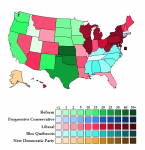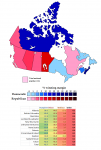- Location
- Derbyshire
To answer the inevitable question, the Electoral college would be:
Liberal: 273, Reform: 134, Bloc: 128, NDP: 3
Liberal: 273, Reform: 134, Bloc: 128, NDP: 3
Prithee explain thyself, mathematician.Alternatively you could use the Transition Method.

It's kind of multiplication for parties losing votes and addition for the ones gaining them.Prithee explain thyself, mathematician

Hmm. That might be doable, indeed. I will think on it.Seriously, though, I'd suggest you go for 1968 for both countries. With the South as Québéc and vice versa, Social Credit as American Independent and vice versa would be quite interesting to see!

I ran the numbers, but I don't think this one would be as interesting as @Makemakean thought, because Social Credit in 1968 was rather less significant than Wallace, so the US map would be pretty much all blue and red.Well, US-in-Canada is easy enough to do for @Makemakean 's request, at least. I include the numbers as well so you can see where Wallace did best (obviously close in Quebec, but also, intuitively I feel, well in Alberta).
View attachment 1891
